This shot was taken at Holly's, the Korean coffee shop that does a fair imitation of Starbucks: Corporate, sterile, decorated in that squared-off polished wood and plastic style so familiar to those who frequent major corporate coffee venues. The only difference: They take FOREVER to make an espresso...But they do it right.
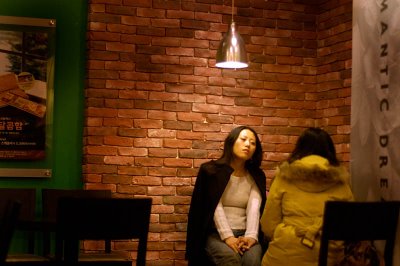
Old guy. Bus. Light. Point, focus...Ker-flop.

Ker-flop.
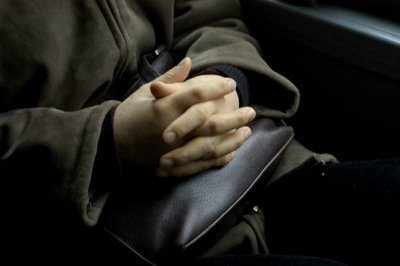
Ker-flop.

Damn, where is this bus, anyway? Hey. Weird light. Shadows. Ker-flop.

Drunk guy, 10 o'clock high. Ker-flop.

I'm not taking photographs. I'm ker-flopping! I'm a ker-floptographer! OK, maybe I should think this one through a little more. Yes, this girl in the next photo is brushing her teeth in the open sewer outside her clothing store. Wanna kiss?
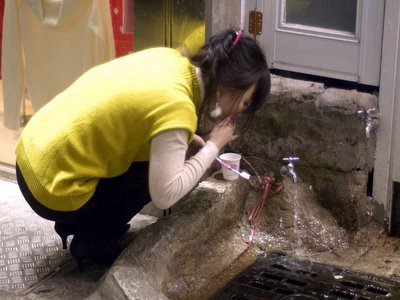
We haven't had rain in weeks and weeks. Sometimes the sky will cloud up in the morning, but it always burns off by mid-day, replaced with a brown stain on the horizon in all directions. Our apartment fills with countless inexplicable dustbunnies that I assume is this thick particulate pollution coming to rest on our floors. Gavin madly sweeps them up day after day while I practice the zen-art of denial.
God knows what is happening to my lungs. For the past few weeks I've had this dry, hacking cough off and on. It never gets bad enough to warrant a doctor, but just reminds me that I am living in a major city. What's worse, our water is saturated with sulphur. A fart smell fills the apartment when we take a shower and permeates our clothes. Oh, and Gavin pointed out that there could possibly be lead in the water. For a country that doesn't give a rat's ass about intellectual property rights, water purity in old run-down apartments like Dongsamjugong might not be a priority. Speaking of priorities, that reminds me: The Korean files!
"Ubiquitous Life Partner," Inexplicably everywhere! Slogan, KT telecom corporation.
"Roading, wrestling, and Writing!" Roading? I'll take 'can't possibly be a verb' for 200, Alex. Sweater.
"If you can avoid pain, enjoy it." As for the rest of us...Pencil case.
"We make dreams of hope.
We wish that all those hopes
come true and we believe
those hopes will make world
beautiful design by Imnibus."
More vaguly egotistical, megalomaniacal blabbering by the Omnibus Corporation. Hmmmm...Pencil case.
Gavin and I attended the wedding of one of our co-workers, Su-jin, over the weekend. I was excited. This was my chance to experience Korean culture up close. My imagination went wild on the bus ride to the conference center (conference center?) where she was to be wed. What where the Korean traditions surrounding the marriage of a man and a woman? What sort of insight would I gain into their culture? I bristled with journalistic gadgetry as I stepped into the conference center: A camera hung around my neck, my pockets bulged with lenses, and my headphone mic cord disappeared somewhere into the depths of my jacket. The video camera waited on standby in my bag and my notepad bulged in my back pocket. This was going to be great!
Go figure: The wedding was mostly western in style and execution. Su-jin wore a white wedding dress. Her father walked her down the aisle.
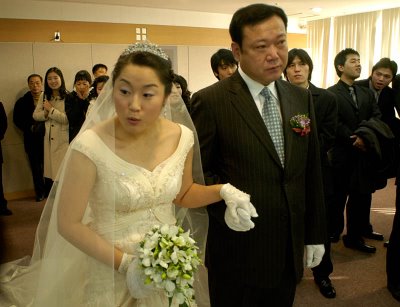
Her husband led the procession. He wore this garish silver and white tux with white gloves and a big, happy smile that just wouldn't go away.

Su-jin made a beautiful bride.

Her fellow Korean teachers were especially happy for her. Many of them, such as Ji-hyeon (front) and Soo-hee (wiping a tear away), were married within the past year or two, and Ji-hyeon admitted a certain amount of girlish longing to 'be in that dress again.'
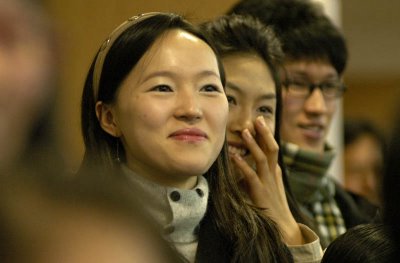
I saw many of my students, from 2E2 and 3E1, and even a few from the high school classes, including Jae-joon.

In true Korean fashion, there was a host of recording devices (besides mine) rolling the whole time. Unlike me, the official documentarians made no effort to be discreet. The best among them hid behind the plants between the preacher and the couple.
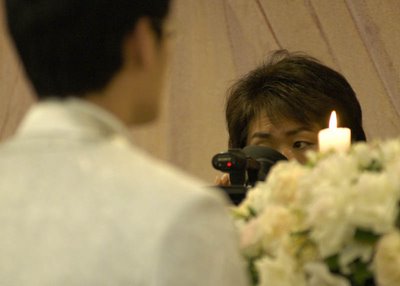
Following the long, unintelligable speech by her father's friend, Su-jin and her husband bowed to their parents.

Then the fun began. Su-jin is well loved by the 2nd grade middle-schoolers. For weeks they secretly met with Su-jin's friend and fellow teacher Sook-hyun and choreographed a song to perform at the wedding. Following the speech by the stand in 'preacher,' they took the stage next to their beloved math teacher, and Sook-hyun stood in the back and choreographed their performance.
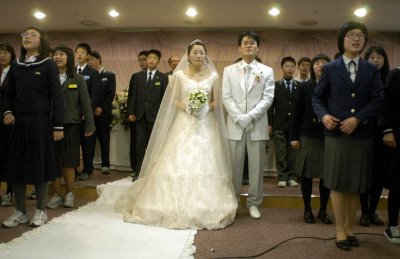
Despite her best efforts to remain calm, the normally cool Su-jin began to cry.
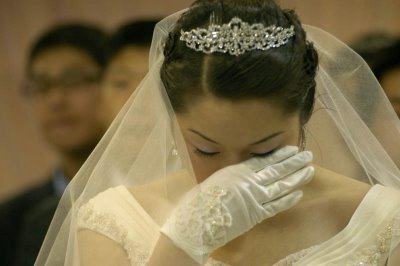
Following the song, Su-jin and her husband walked off the stage and down the aisle, he still wearing that high-wattage smile. She looks a little worried for him in this photo.

Unlike the Western wedding that I have witnessed, there was no reception for the hundreds of people in attendance. Su-jin, her husband, their families and close friends went to their own private reception while the rest of us fended for ourselves. The other teachers took Gavin and I to lunch at a Chinese restaurant in Beomil-dong and then Gavin and I went home and prepared for the week ahead.
I tend to use my breaks to break out of ESS for a few minutes. I grab a cup of coffee, a bite to eat, or I just wander around Nampo-dong for a half-hour with my iPod on, lost in thought. One interesting aspect of Nampo-dong is the frenetic nature of the architecture. The history, culture and obsessive-compulsive nature of Korea is all at once visible if you take a moment to look up.
Cross the main road on the south side of the district and enter the International Market and you are confronted with this fascinating aspect of Korean infrastructure. The average intersection is teeming with commercial life. Old, plump, weathered ajummas swathed in rags, down jackets and scarves huddle against the cold while keeping watch over their wares: Endless buckets filled with every conceivable form of sealife wriggling desperatly against inevitability, dried fish hanging like panties from clothes hangers, trinkets, old dusty electric shavers, watches that don't tick, watches that do, clothes, bottles of American liquors covered in a fine dust, and out-of-date skin care products with dubious names. People are everywhere, squeezing past one another while they poke and prod the products; stopping every now and then to haggle over an item, buy a bag of this or a couple of those. There are live deepsea crabs so incredibly large I joked once that instead of a bag the ajumma just gives you a leash and you walk it home. The entire scene is lit with bare incandescent bulbs hanging by their power cords from the rafters of the aforementioned buildings.
Turn and look in any direction and you will see the same scene stretching off down the endless alleyways. It's only when you look up that your senses get turned upside down. In much of the International Market, there aren't any lights on in the upper floors of the buildings. Old neon signs in a 1960's style from businesses long since closed hang off of the old brick walls and block dusty windows where sometimes there can be seen a faint glow from within. Gavin suggested that perhaps the people who work in the market below live in the floors above, and that makes sense.
Much like the road I see is only one layer of concrete poured onto a path originally laid down long before I walked it, the buildings towering above me are the remnants of a series of progressivly more modern facades from a host of varied and different businesses nailed and torn down over the years. The buildings are like actors who don different costumes depending on the production desired by their directors. Each new shop alters it's outside appearence to match the spirit of their products. However, look under and around the plastic and brushed metal of some new shop hawking jeans at 150,000 won each and you will find the same old brick and morter of a buidling built when it would take a Korean years to save up that much money.
I like to wonder about the history of the buildings around me as I take my breaks walking the old streets of the market. I watch as some businesses close and others open in their place. I find new shops and make mental notes of items found and where and for how much. I am beginning to remember faces, and sometimes those faces recognize me.
"Hello, Stee-bu!" says the ajumma as she and her 'wingajumma' run their bustling, steaming dokpokki stand behind ESS as I pass every day. I smile and wave back as I make my way up the crowded alley. Sometimes these long walks will lead to a purchase. I'm never searching for anything more a few minutes of peace, but periodically I come back with a trinket that caught my eye or a stack of blank flash cards or markers. Some days I actually have a mission, an item I need to buy. Oddly, its the days that I try to find something that I come up empty-handed. I was having just such a day a few weeks ago as I scoured the market for gifts for my family.
I was hurrying back to ESS when I noticed a building on my right. It was large, gray; a hideous windowless beast of a structure built to look 'modern,' and failing miserably. It rose a few stories above it's neighbors, as if it were too good for the brick and morter rabble surrounding it, though it was obviously unoccupied. The building's parking garage was still in operation, like the beating heart of a comatose patient, and an attendant stood by to park cars for customers taking their business elsewhere.
The building depressed me. A badly shredded "Grand Opening" sign flapped limply in the stiff wind racing down the alley. All the words were torn away except the "ran" in "Grand." Ran. Ran away. Disappeared. No matter. Eventually there will be another store, another owner, another opening, and depending on his finances, it will be 'grand' too. Store fronts never remain empty for long in Nampo-dong.
Start-up costs and business licenses must be cheap, muses Gavin from time to time. Where there are not storefronts, people sell from carts and wagons and covered tents, some in the middle of the street. In this situation, with so many businesses, who believes their business will succeed where others have failed? I know I mention this all the time, but it never manages to blow my mind. Within days or weeks of a store folding, an identical store opens up with a different name, different facade, but the same wares at the same prices. The owner hangs 'good luck' banners, has a sale and hires pretty girls to wiggle their bodies out front to the sounds of bad techno blaring from a Karaoke machine. Will this draw people in? Will this business work? What magic potion or endangered species has this owner rubbed on himself or his business to please the Gods or tempt fate into smiling upon his adventure in cellphone sales?
Who cares. There are a limitless number of people willing to to roll the dice and win the pot. I guess that's why the old gray building disturbs me: It's unoccupied, and has been for longer than normal. I guess nobody thinks they can make a business work here, and I have my theories as to why. It's tall. It's modern-looking. It's intended to be a multi-level department store but it lives in the middle of a street-market. It doesn't fit in. It's just too new.
OK, I know I talk alot about the market, so I'll try to lay off for a few updates. I hope you liked the photographs and of course, I know some of you only read this for the Korean Files, but that's OK. Maybe I'll put together a compilation when I am done here, a Korean Files wrap-up. Well, until next time. Peace. --Notes
No comments:
Post a Comment